Complete Solutions to Single Correct of chapter PHOTOELECTRIC EFFECT of Class 12 book with complete answers and questions
| Class 12 | PHYSICS |
| Chapter | PHOTOELECTRIC EFFECT |
| CENGAGE PHYSICS | Single Correct |
| Number Of Questions | 100 |
| Academic Year | 2023-24 |
The minimum orbital angular momentum of the electron in a hydrogen atom is
View SolutionAn electron beam accelerated from rest through a potential difference of 5000 V in vacuum is allowed to impinge on a surface normally. The incident current is 50`muA` and if the electrons come to rest on striking the surface the force on it is
View Solution`10^-3` W of `5000A` light is directed on a photoelectric cell. If the current in the cell is `0.16muA`, the percentage of incident photons which produce photoelectrons, is
View SolutionWhen a certain metallic surface is illuminated with monochromatic light of wavelength `lamda`, the stopping potential for photoelectric current is `3V_0` and when the same surface is illuminated with light of wavelength `2lamda`, the stopping potential is `V_0`. The threshold wavelength of this surface for photoelectrice effect is
View SolutionA particle of mass `10^31`kg is moving with a velocity equal to `10^5ms^-1`. The wavelength of the particle is equal to
View SolutionThreshold frequency for a certain metal is `v_0`. When light of frequency `2v_0` is incident on it, the maximum velocity of photoelectrons is `4xx10^8 cm s^-1`. If frequency of incident radiation is increased to `5v_0`, then the maximum velocity of photoelectrons, in cm `s^-1`, will be
View SolutionLight of wavelength `0.6mum` from a sodium lamp falls on a photocell and causes the emission of photoelectrons for which the stopping potential is 0.5V. With light of wavelength `0.4mum` from a murcury vapor lamp, the stopping potential is `1.5V`. Then, the work function [in electron volts] of the photocell surface is
View SolutionUltraviolet light of wavelength 300nn and intensity `1.0Wm^-2` falls on the surface of a photosensitive material. If one per cent of the incident photons produce photoelectrons, then the number of photoelectrons emitted per second from an area of 1.0 `cm^2` of the surface is nearly
View SolutionRadiation of wavelength `lambda` in indent on a photocell . The fastest emitted electron has speed `v` if the wavelength is changed to `(3 lambda)/(4)` , then speed of the fastest emitted electron will be
View SolutionTwo identical photo-cathodes receive light of frequencies `v_1` and `v_2`. If the velocities of the photoelectrons (of mass m) coming out are `v_1` and `v_2` respectively, then
View SolutionIf the intensity of radiation incident on a photocell be increased four times, then the number of photoelectrons and the energy of photoelectrons emitted respectively become.
View Solutionthe work function of metal is W and `lamda` is the wavelength of the incident radiation. There is no emission of photoelecrons when
View SolutionIf a surface has work function of 3.00eV, the longest wavelength of light which will cause the emission of electrons is
View Solution
In the experiment on photoelectric effect, the graph between `E_K(max)` and v is found to be a straight line as sshoen in fig. The threshold frequency and Planck's constant according to this graph are
View SolutionMonochromatic light incident on a metal surface emits electrons with kinetic energies from zero to 2.6 eV. What is the least energy of the incident photon if the tightly bound electron needs 4.2eV to remove?
View SolutionThe work function for sodium surface is 2.0eV and that for alluminium surface is 4.2eV. The two metals are illuminated with appropriate radiations so as to cause proto emission. Then
View SolutionA metal surface is illuminated by a light of given intensity and frequency to cause photoemission. If the intensity of illumination is reduced to one-fourth of its original value, then the maximum KE of emitted photoelectrons will become.
View SolutionRepresenting the stopping potential V along y-axis and `((1)/(lamda))` along x-axis for a given photocathode, the curve is a straight line, the slope of which is equal to
View SolutionIn the intercept on the y-axis is equal to
View Solution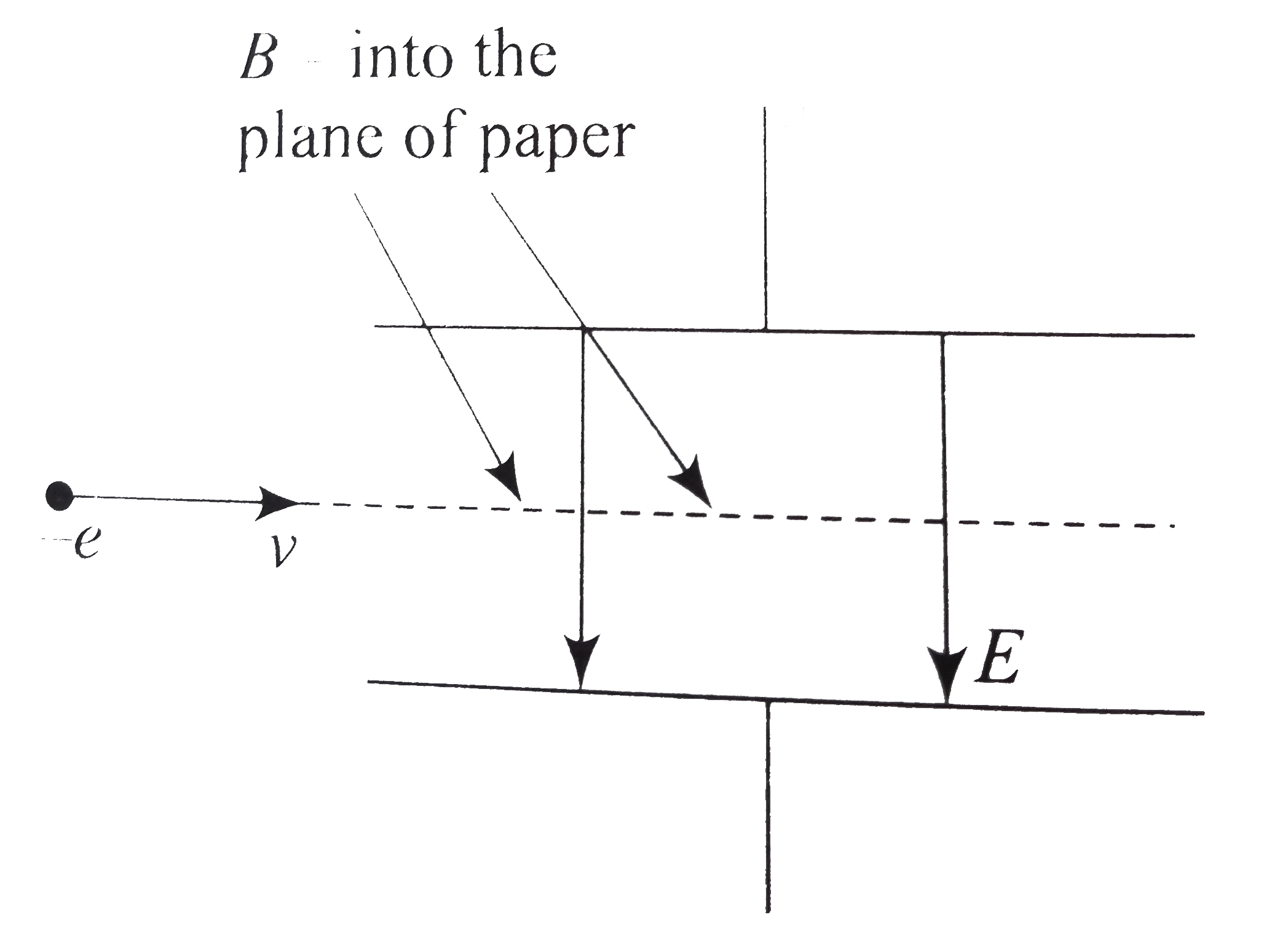
Electrons taveling at a velocity of `2.4xx10^(6) ms^(-1)` enter a region of crossed electric and magnetic fields as shoen in Fig. If the electric field is `3.0xx10^(6)` Vm and the flux density of the magnetic field is 1.5 T, the electrons upon entering the region of the crossed fields will
View SolutionA surface irradiated with light `lamda=480 nm` gives out electrons with maximum velocity v `ms^(-1)`, the cut off wavelength being 600 nm. The same surface would release electrons with maximum velocity `2vms^(-1)` if it is irradiated by light of wavelength.
View SolutionIn an experiment on the photoelectric effect, an evecuated photocell with a pure metal cothode is used. Which graph best represents the variation of B, the minimum potential defference needed to prevent current from flowing, when x, the frequency of the incident light, is varied?
View Solution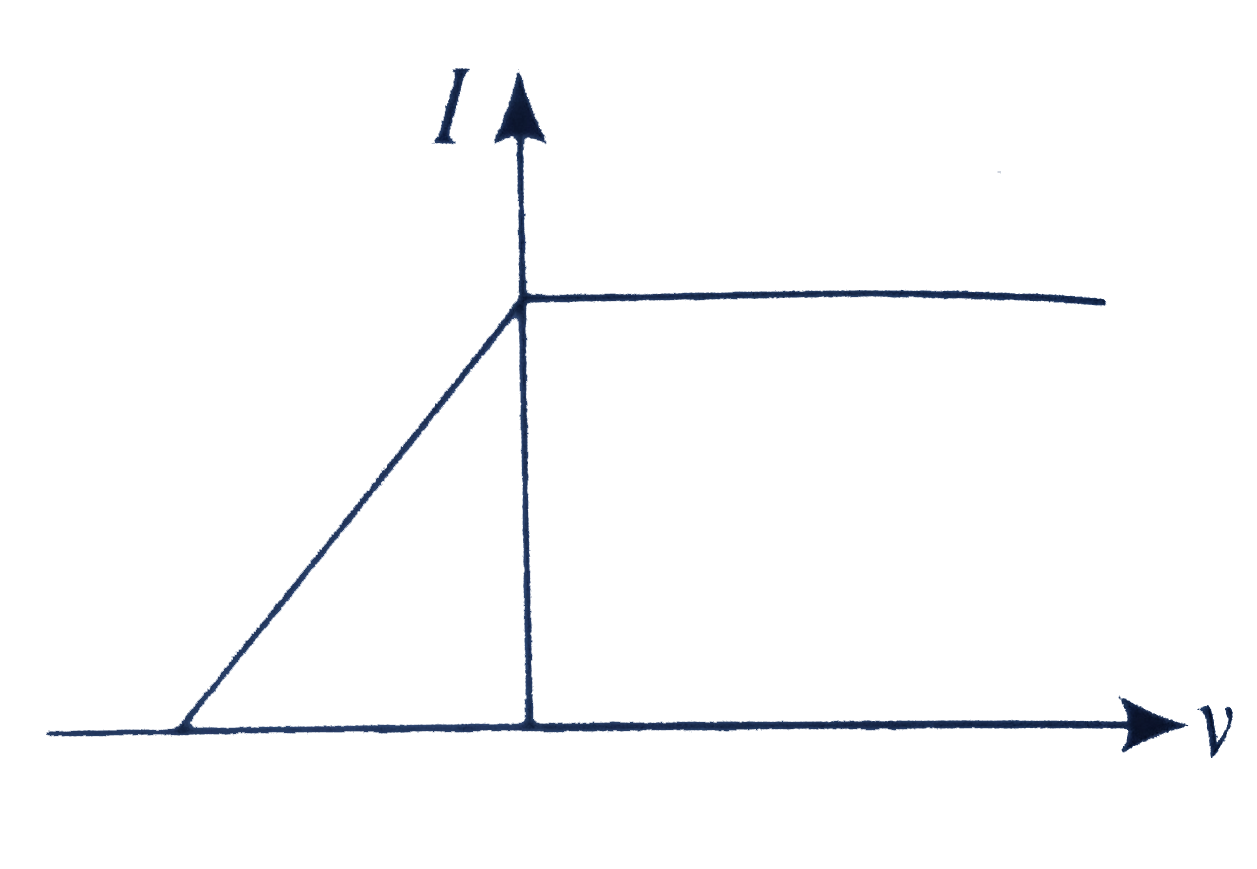
A metal surface in an evacuated tube is illuminated with monochromatic light causing the emission of photoelectrons. For a given intensity of light, a graph between saturation current and potential of the electrode is given in Fig. If the experiment were repeated with light of twice the intensity but the same wavelength, which of the graphs below would best represent the new relation between I and V?(Dotted represents initial condition)
View SolutionIf stopping potentials corresponding to wavelengths `4000A` and `4500A` are 1.3 V and 0.9 V, respectively, then the work function of the metal is
View SolutionThe photoelectric threshold of a certain metal is `3000A`. If the radiation of `2000A` is incident on the metal
View SolutionThe frequency and the intensity of a beam of light falling on the surface of a photoelectric material are increased by a factor of two. This will
View SolutionThe frequency of incident light falling on a photosensitive metal plate is doubled, the KE of the emitted photoelectrons is
View SolutionLights of two different frequencies whose photons have energies 1 and 2.5 eV, respectively, successively illuminate a metal whose work function is 0.5 eV. The ratio of the maximum speeds of the emitted electrons
View SolutionA proton when accelerated through a potential difference of V volt has a wavelength `lamda` associated with it. An alpha-particle in order to have the same `lamda` must be accelerated through a potential difference of
View SolutionGiven that a photon of light of wavelength `10,000A` has an energy equal to 1.23 eV. When light of wavelength `5000A` and intenstiy `I_0` falls on a photoelectric cell, the saturation current is `0.40xx10^(-6)A` and the stopping potential is 1.36V, then the work function is
View SolutionIn the previous question, if the intensity of light is made `4I_0`, then the stopping potential will become
View Solutionif the intensity of light is made `4I_0`, then the saturation current will become
View Solutionif the cathode and the anode are kept at the same potential, the emitted electrons have
View Solutionif the wavelength is chaged to `4000A`, then stopping potential will become
View SolutionA cesium photocell, with a steady potential difference of 60 V across it ,is illuminated by a small bright light placed 1m away. When the same light is placed 2m away, the electrons crossing the photocell
View SolutionIf 5% of the energy supplied to a bulb is irradiated as visible light, how many quanta are emitted per second by a 100 W lamp? Assume wavelength of visible light as `5.6xx10^(-5)` cm.
View SolutionWhich of the following graphs correctly represents the variation of particle momentum with associated de Broglie wavelength?
View SolutionFive volt of stopping potential is needed for the photoelectrons emitted out of a surface of work function 2.2 eV by the radiation of wavelength
View SolutionThe work function for tungsten and sodium are `4.5 eV` and `2.3 eV` respectively . If the threshold wavelength `lambda` for sodium is `5460 Å`, the value of `lambda` for tungsten is
View SolutionIn a series of photoelectric emission experiments on a certain metal surface, possible relationships between the following quantities were investigated: threshold frequency `f_0`, frequency of incident light f, light intensity P, photocurrent I, maximum kinetic energy of photoelectrons `T_(max)`. Two of these quantities, when plotted as a graph of y against x, give a straight line through the origin. Which of the following correctly identifies x and y with the photoelectric quantities ?
View Solution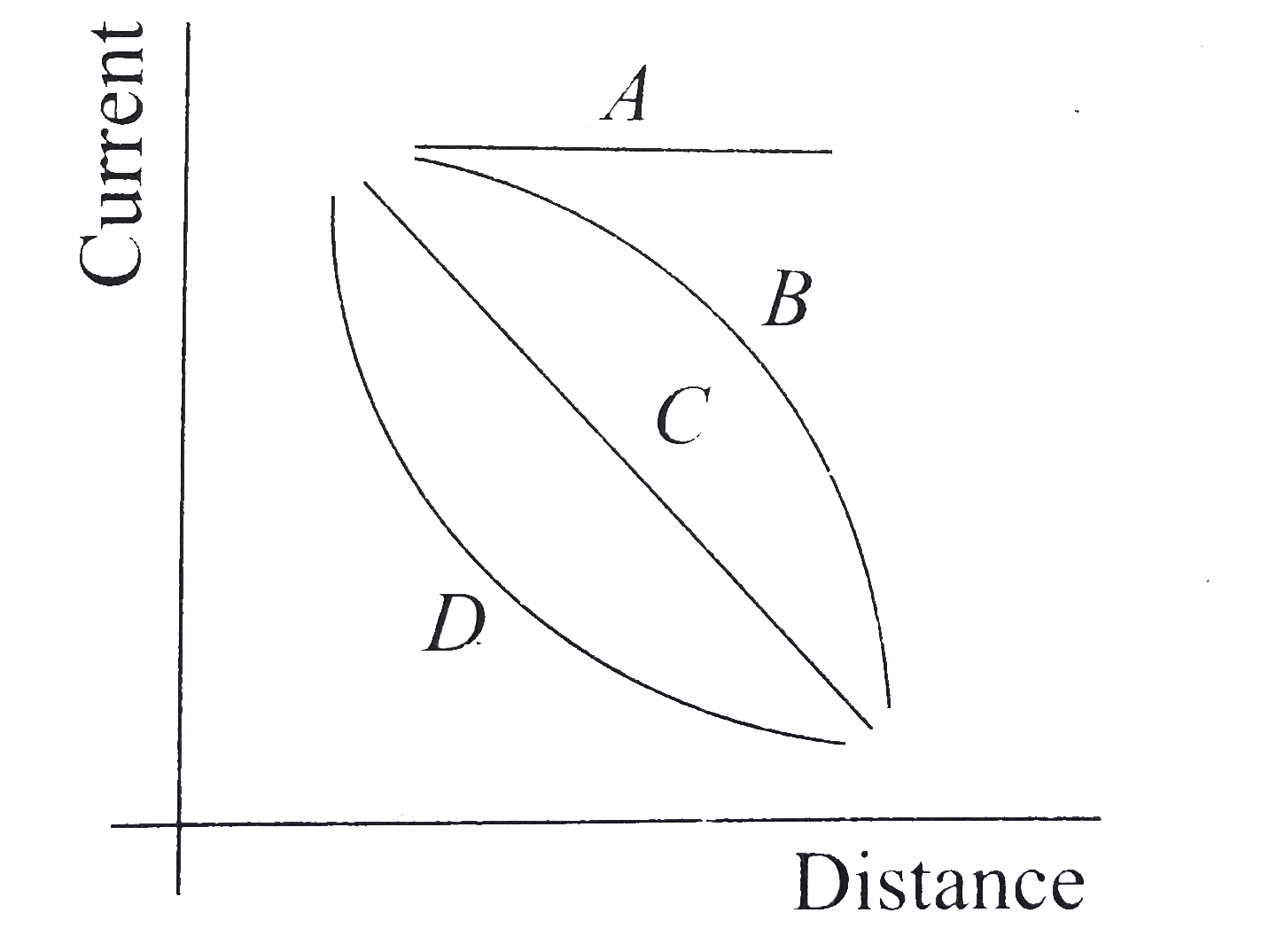
A point source causes photoelectric effect from a small metal plate. Which of the curves in Fig. may represent the saturation photo-current as a function of the distance between the source and the metal?
View SolutionLet p and E denote the linear momentum and energy of a photon. If the wavelength is decreased,
View SolutionLight from a hydrogen tube is incident on the cathode of a photoelectric cell the work function of the cathode surface is `4.2 eV`. In order to reduce the photo - current to zero the voltage of the anode relative to the cathode must be made
View SolutionThe photoelectric threshold for some material is 200 nm. The material is irradiated with radiations of wavelength 40 nm. The maximum kinetic energy of the emitted photoelectrons is
View SolutionThe human eye can barely detect a yellow lings (`lamda=6000A`) that delivers `1.7xx10^(-18)`W to the retina. The number of photons per second falling on the eye is nearest to
View SolutionX-rays are used to irradiate sodium and copper surfaces in two separate experiments and stopping potential are determined. The stopping potential is
View SolutionAn electron is accelerated through a potential difference of `200` volts. If `e//m` for the electron be `1.6 xx 10^(11)` coulomb/kg, the velocity acquired by the electron will be
View Solution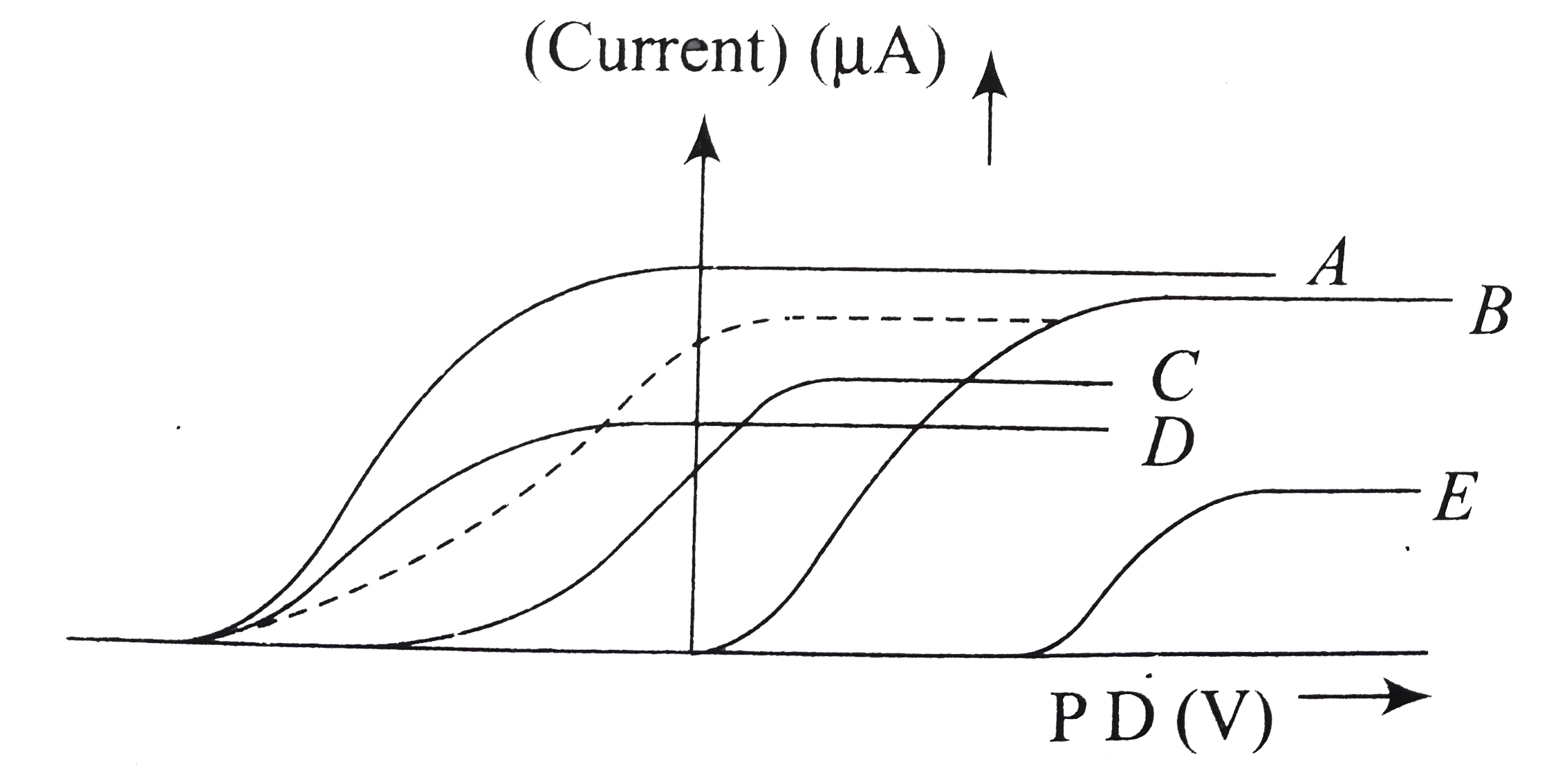
A photoelectric cell is connected to a source of variable potential difference, connected across it and the photoelectric current resulting `(muA)` is plotted against the applied potential difference (V). The graph in the broken line represents one for a given frequency and intensity of the incident radiation . If the frequency is increased and the intensity is reduced, which of the following graphs of unbroken line represents the new situation?
View SolutionPhotoelectric work- function of a metal is `1 eV.` Light of wavelength `lambda = 3000 Å` falls on it. The photoelectrons come out with maximum velocity
View SolutionIf a surface has a work function 4.0 eV, what is the maximum velocity of electrons liberated from the surface when it is irradiated with ultraviolet radiation of wavelength 0.2`mum`?
View SolutionAn image of the sun is formed by a lens, of the focal length of 30 cm, on the metal surface of a photoelectric cell and a photoelectric current I is produced. The lens forming the image is then replaced by another of the same diameter but of focal length 15 cm. The photoelectric current in this case is
View SolutionA modern 200 W sodium street lamp emits yellow light of wavelength 0.6 `mum`. Assuming it to be 25% efficient in converting electrical energy to light, the number of photons of tellow light it emits per second is
View SolutionThe work function of a metallic surface is 5.01 eV. The photoelectrons are emitted when light of wavelength `2000A` falls on it. The potential difference applied to stop the fastest photoelectrons is
View SolutionAn electron of mass `m_e` and a proton of mass `m_p` are accelerated through the same potential difference. The ratio of the de Broglie wavelength associated with an electron to that associated with proton is
View SolutionA material particle with a rest mass `m_o` is moving with a velocity of light c. Then, the wavelength of the de Broglie wave associated with it is
View SolutionIf a photocell is illuminated with a radiation of `1240 A`, then stopping potential is found to be 8 V. The work function of the emitter and the threshold wavelength are
View SolutionSilver has a work function of 4.7 eV. When ultraviolet light of wavelength 100 mm is incident upon it, a potential of 7.7 V is required to stop the photoelectrons from reaching the collector plate. How much potential will be required to stop the photoelectrons when light of wavelength 200mm is incident upon silver?
View SolutionThe equation E=pc is valid
View SolutionWhen a centimeter thick surface is illuminated with light of wavelength `lamda`, the stopping potential is V. When the same surface is illuminated by light of wavelength `2lamda`, the stopping potential is `(V)/(3)`. Threshold wavelength for the metallic surface is
View SolutionLight of wavelength `lamda` strikes a photoelectric surface and electrons are ejected with kinetic energy K. If K is to be increased to exactly twice its original value, the wavelength must be changed to `lamda'` such that
View SolutionThe ratio of moment of an electron and an `alpha`-particle which are accelerated from rest by a potential difference of `100V` is
View SolutionThe kinetic energy of an electron is E when the incident wavelength is `lamda` To increase ti KE of the electron to 2E, the incident wavelength must be
View SolutionThe KE of the photoelectrons is E when the incident wavelength is `(lamda)/(2)`. The KE becomes 2E when the incident wavelength is `(lamda)/(3)`. The work function of the metal is
View SolutionIf `lamda_0` stands for mid-wavelength in the visible region, the de Broglie wavelength for 100 V electrons is nearest to
View SolutionThe threshold frequency for certain metal is `v_0`. When light of frequency `2v_0` is incident on it, the maximum velocity of photoelectrons is `4xx10^(6) ms^(-1)`. If the frequency of incident radiation is increaed to `5v_0`, then the maximum velocity of photoelectrons will be
View SolutionIn a photoelectric emission, electrons are ejected from metals X and Y by light of frequency f. The potential difference V required to stop the electrons is measured for various frequencies.. If Y has a greater work function than X, which graph illustrates the expected results?
View SolutionIn a photoelectric cell, the wavelength of incident light is chaged from `4000A` to `3600A`. The change in stopping potential will be
View SolutionWhen a metallic surface is illuminated by a light of frequency `8xx10^(14)`Hz, photoelectron of maximum energy 0.5 eV is emitted. When the same surface is illuminated by light of frequency `12xx10^(14)` Hz, photoelectron of maximum energy 2 eV is emitted. The work function is
View SolutionThe de Broglie wavelength of neutrons in thermal equilibrium is (given `m_n=1.6xx10^(-27)`kg)`
View SolutionA partical of mass M at rest decays into two Particles of masses
`m_1 and m_2` having non-zero velocities. The ratio of the de - Broglie wavelengths
of the particles `lambda_1| lambda_2` is
(a) `m_1//m_2` (b)`m_2// m_1` (c ) 1 (d)`sqrt2 // sqrt1`
View SolutionWhat is the energy of a proton possessing wavelength `0.4A`?
View SolutionAn electron and a photon possess the same de Broglie wavelength. If `E_e` and `E_ph` are, respectively, the energies of electron and photon while v and c are their respective velocities, then `(E_e)/(E_(ph))` is equal to
View SolutionIn Q.72, if the velocity of electron is 25% of the velocity of photon, then `(E_e)/(E_(ph))` equals
View SolutionAn electron and a photon, each has a wavelength of `1.2A`. What is the ratio of their energies?
View SolutionWhat is the wavelength of a photon of energy 1 eV?
View SolutionIf `lamda_1` and `lamda_2` denote the wavelength of de Broglie waves for electrons in the first and second Bohr orbits in a hydrogen atom, the `(lamda_1)/(lamda_2)` is equal to
View SolutionWhich curve shows the relation ship between the energy R and the wavelength `lamda` of a photon of electromagnetic radiation?
View SolutionWork function of nickel is 5.01 eV. When ultraviolet radiation of wavelength `200A` is incident of it, electrons are emitted. What will be the maximum velocity of emitted electrons?
View SolutionAn electron is accelerated through a potential difference of V volt. It has a wavelength `lamda` associated must be accelerated so that its de Broglie wavelength is the same as the of a proton? Take mass of proton to be 1837 times larger than the mass of electron.
View SolutionThe kinetic energy of most energetic electrons emitted from a metallic surface is doubled when the wavelength `lamda` of the incident radiation is changed from 400 nm to 310 nm. The work function of the metal is
View SolutionHow many photons are emitted per second by a 5 mW laser source operating at 632.8 nm?
View Solution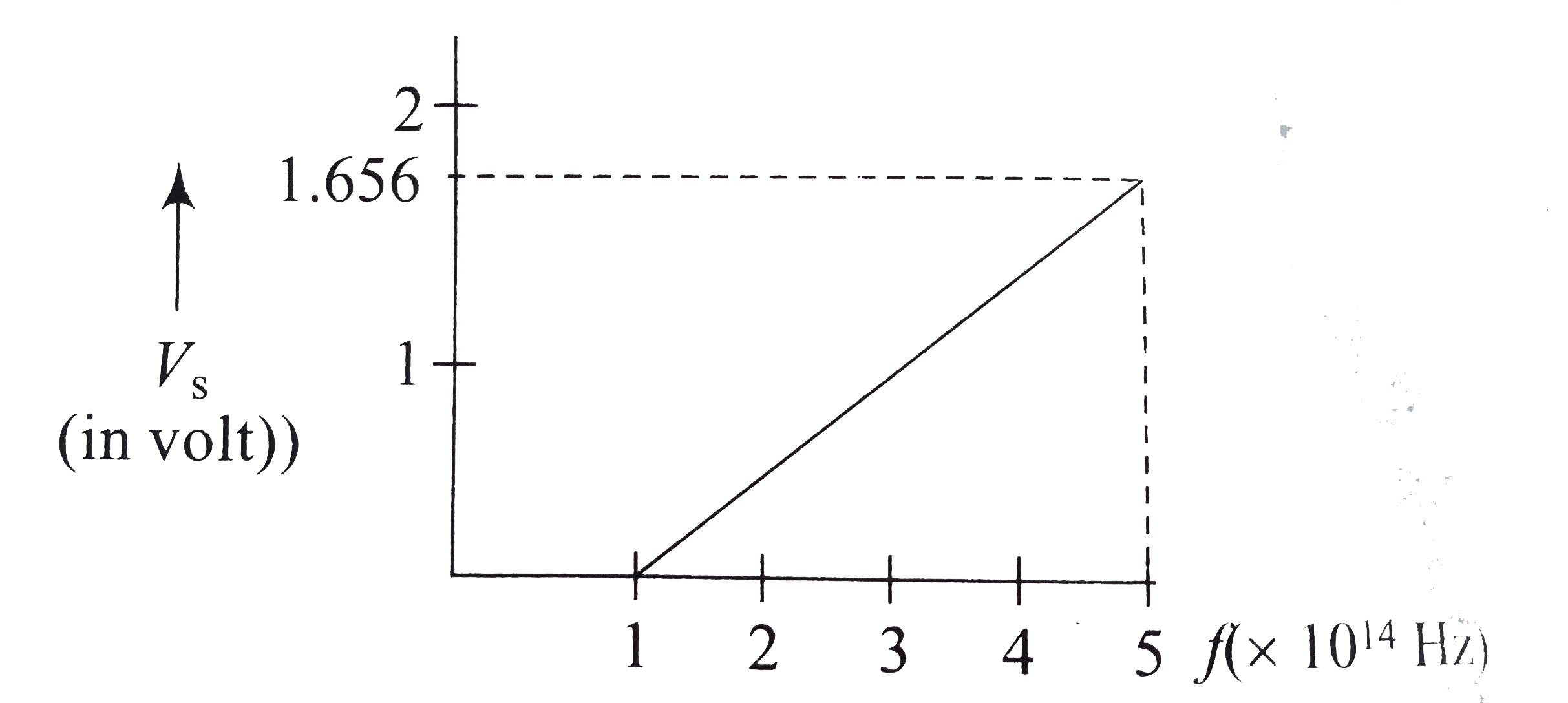
Figure shows the plot of the stopping potential versus the frequency of the light used in an experiment on photoelectric effect. The ratio `(h)/(e)` is
View Solutionin Q-82, the work function is
View SolutionTwo identical metal plates show photoelectric effect. Light of wavelength `lamda_A` falls on plate A and `lamda_B` fall on plate B `lama_A=2lamda_B`, The maximum KE of the photoelectrons are `K_A` and `K_B`, respectively, Which one of the following is true?
View SolutionThe potential difference applied to an X-ray tube is V The ratio of the de Broglie wavelength of electron to the minimum wavlength of X-ray is directrly proportional to
View SolutionThe maximum velocity of electrons emitted from a metal surface is v. What would be the maximum velocity if the frequency of incident lightis increased by a factor of 4?
View SolutionA homogeneous ball (mass=m) of ideal black material at rest is illuminated with a radiation having a set of photons (wavelength`=lamda`), each with the same momentum and the same energy. The rate at whoch photons fall on the ball is n. the linear acceleration of the ball is
View SolutionThe eye can detect `5xx10^(4)` photons `(m^2s)^(-1)` of green light (`lamda=5000A)`, whole ear can detect `10^(-13)Wm^(2)` . As a power detector, which is more sensitive and by what factor?
View SolutionA photon of wavelength `0.1 A` is emitted by a helium atom as a consequence of the emission of photon. The KE gained by helium atom is
View SolutionA monochromatic source of lightis placed at a large distance d From a metal surface. Photoelectrons are ejected at rate n, the kinetic energy being E. If the source is brought nearer to distance `(d)/(2)`, the rate and kinetic energy per photoelectron become nearly
View SolutionA. How many photons of a tradiation of wavelength `lamda=5xx10^(-7)` m must fall per second on a blackened plate in order to produce a force of `6.62xx10^(-5)`N?
B. At what rate will the temperature of plate rise if its mass is 19.86kg and specific heat is equal to `2500J(kgK^(-1))`?
View Solution ltBRgt A nozzle throws a stream of gas against a wall with a velocity v much larger than the thermal agitation of the molecules. The wall deflects the molecules without changing the magnitude of their velocity. Also, assume that the force exerted on the wall by the molecules is perpendicular to the wall. (This is not strictly true of a rough wall). Find the force exerted on the wall
ltBRgt A nozzle throws a stream of gas against a wall with a velocity v much larger than the thermal agitation of the molecules. The wall deflects the molecules without changing the magnitude of their velocity. Also, assume that the force exerted on the wall by the molecules is perpendicular to the wall. (This is not strictly true of a rough wall). Find the force exerted on the wall
View SolutionA plane light wave of intensity `I=0.20Wcm^-2` falls on a plane mirror surface with reflection coefficient `rho=0.8`. The angle of incidence is `45^circ`. In terms of corpuscular theory, find the magnitude of the normal pressure exerted on that surface.
View Solution
A plane wave of intensity `I=0.70W cm^(-2)` illuminates a sphere with ideal mirror surface. The radius of sphere is `R=5.0cm`. From the standpoint of photon theory, find the force that light exerts on the sphere.
View SolutionLight of wavelength `lamda` from a small 0.5 mW He-Ne laser source, used in the school laboratory, shines from a spacecraft of mass 1000 kg. Estimate the time needed for the spacecraft to reach a velocity of `1.0km^(-1)` from rest. The momentum p of a photon of wavelength `lamda` is given by `p=(h)/(lamda)`, where h is Planck's constant.
View SolutionAn electron is accelerated by a potential difference of 50 V. Find the de Broglie wavelength associated with it.
View SolutionAn `alpha`-particle and a proton are fired through the same magnetic field which is perpendicular to their velocity vectors. The `alpha`-partcles and the proton move such that radius of curvature of their paths is same. Find the ratio of their de Broglie wavelengths.
View SolutionFind the ratio of de Broglie wavelength of a proton and as `alpha`-particle which have been accelerated through same potential difference.
View SolutionAll electrons ejected from a surface by incident light of wavelength 200nm can be stopped before traveling 1m in the direction of a uniform electric field of `4 NC^(-1)`. The work function of the surface is
View SolutionIf the short wavelength limit of the continous spectrum coming out of a Coolidge tube is `10 A`, then the de Broglie wavelength of the electrons reaching the target netal in the Coolidge tube is approximately
View Solution
Single Correct questions and complete solutions for chapter PHOTOELECTRIC EFFECT of CENGAGE PHYSICS (HINGLISH) of Class 12